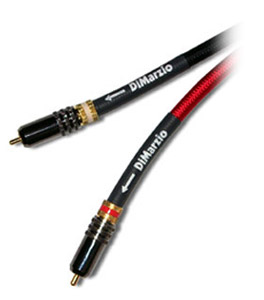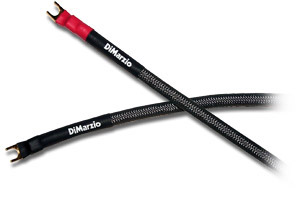![[SoundStage!]](../titles/sslogo3.gif) Home
Audio Home
Audio Equipment Review |
|||||||||||||||||
December 2000 DiMarzio M-Path Interconnects and Super M-Path Speaker Cablesby Marc Mickelson
Who or what is DiMarzio? An industry leader in the manufacture of guitar pickups, that's who. Why then are we reviewing interconnects and speaker cables from DiMarzio, a pro-sound company? Because they were recommended to us by Tyll Hertsens of Headroom, who has heard them and believes them to be an especially good value. But this tells only part of the story. Company president Larry DiMarzio, as I have come to know, is an avid audiophile, and the M-Path interconnects and Super M-Path speaker cables are an outgrowth of his high-end-audio interests. Both the M-Path interconnects ($150 USD per three-foot pair) and Super M-Path speaker cables ($500 per eight-foot pair) look rather plain clad in their woven nylon overbraid. They are very flexible cables, which is no small consideration for those of us who need to snake them between and behind the components on our racks. DiMarzio's goals in creating their speaker cables and interconnects were simple but important: deliver the best connection between audio components while minimizing microdynamic "effects" that change music for the worse. The DiMarzio speaker cables are made of 9-gauge OFC stranded wire bundled in groups of seven strands, two lengths of cable per speaker, one each for positive and negative. The connectors are ultrasonically welded, which according to Larry DiMarzio improves the sound of the cables and overcomes a potential problem of using stranded wire: the dreaded wire/solder "nugget" at the termination point, which is no good for sound. The M-Path interconnects are made of 16-gauge OFC wire with a 16-gauge drain wire. These also have welded connections, conforming to Larry DiMarzio's "weld it, seal it, and forget it" philosophy. The interconnects are available only with RCA terminations for now because the company hasn't encountered an XLR connector yet that offers physical connection to DiMarzio standards. Both the speaker cables and interconnects are Teflon insulted and internally sealed to increase longevity. Larry DiMarzio and I both recall having old pairs of the Monster Cable stranded speaker cables that turned greenish brown with age, so it's good to know that DiMarzio has addressed this. System
I used the DiMarzio cables in my reference system, which remained relatively stable over the course of the review period. My reference Lamm L2 preamp and ML2 amplifiers drove a pair of the magnificent Wilson WATT/Puppy 6 speakers for most of the review period, Speaker Art Proklaim IIs or Soliloquy 6.3s filling in for short periods. CDs spun in either a Mark Levinson No.39, used as both a CD player and transport, or Pioneer DV-525 DVD player. DACs in use were the Bel Canto DAC1 or Perpetual Technologies P-1A/P-3A combination. Power cords were from Audio Magic, ESP, TARA Labs, and JPS Labs, with the Shunyata PowerSnakes seeing lots of use due to an upcoming review. A PS Audio P300 Power Plant and pair of Richard Gray's Power Companies provided juice to my system, neither in use at the same time -- too many variables for reviewing purposes. Larry DiMarzio was insistent that I compare his relatively inexpensive cables to high-ticket wire from other companies. So I brought out the big guns from TARA Labs and JPS Labs, settling on even more expensive offerings from Nordost for the cable-to-cable showdown. The DiMarzio sound Listening to interconnects and speaker cables can be the drudgery of audio reviewing. These days most audiophile-grade wires you are likely to encounter have little sound of their own, with more than a few offering transparency and detail that are so exceptional it's hard to say much about them other than that they are transparent and detailed. Thus the task is figuring out exactly what each set of cables is doing and conveying this, no matter how perceptibly small. This is not always an easy task. The DiMarzio interconnects and speaker cables do have a sound, although their character is easily discernible only in relation to other cables. In a word, they are impressionistic -- offering a warmish, enveloping sonic view of things. However, don't let this characterization give you the wrong idea -- that their sound is the equivalent of a classic tube amp. You will still hear what your equipment does with the DiMarzio cables in your system; the sound may just be different, leaning more toward harmonic richness than you may have experienced previously, but not so much so that the music will be a syrupy mess. With the DiMarzio cables in my system, I listened to a lot of music with rhythmic drive, which brings me to another trait: deep and powerful bass, especially from the speaker cables, which do bass in a growling way. Recently Bill Cowen reminded me that some music that begs to be played loud, and at the top of his list was Stevie Ray Vaughan. The power of suggestion being what it is, I immediately pulled out the remastered version of Soul to Soul [Epic/Legacy EK65872]. The bass line on "Lookin' Out the Window" was consummately driving, but I really dug the bonus track "Little Wing/Third Stone from the Sun," its bass line being rather atmospheric. In fact, this is another good word for describing the overall sound of the M-Path interconnects and Super M-Path speaker cables: They are atmospheric in their rendering of the music, adding a bit of tonal color here, a bit of warmth there. And that little extra warmth pays off in terms of harmonics, which take on more a life of their own with the DiMarzio interconnects and speaker cables in use. I reviewed the Hot Club of Cowtown's newest collection Dev'lish Mary [HighTone HCD8124] a month ago, and I still can't get it off my ready-to-play pile. You may not think that stringed instruments -- bass, fiddle and guitar -- can make such raucous music, but this CD will prove otherwise. I noticed with the DiMarzio cables that the whole CD took on a richer hue, sort of like the change from one component to another that's slightly less insistent. The low-end drive was still there, but the stringed instruments had more body, or so I perceived. I've listened to this CD many times and with many permutations and combinations of equipment, and the DiMarzio cables fixed themselves in my mind via this CD -- no small trick. At their price, the M-Path interconnects and Super M-Path speaker cables may gravitate naturally to use in systems of more modest price. They will work their magic there, but they deserve a listen in more pricey systems too -- although their price may hinder this. As silly as it sounds, it's hard for an inexpensive product to break into the big-money leagues, but I guess this will only make those who let the sound they hear with the DiMarzio cables all the more happy at the potential extra jingle left in their pockets. Comparison As I stated, Larry DiMarzio urged me to compare the M-Path interconnects and Super M-Path speaker cables to mega-buck offerings from other companies. The greatest contrast occurred between the DiMarzio cables and the very fine, and expensive, wires from Nordost, Quattro-Fil interconnect ($1600 per meter pair) and SPM Reference speaker cables ($3350 per eight-foot pair) specifically. Supreme "unthereness" is the Nordost cables' strong suit, and they do it very well, sounding faster, more open, and more resolving than the DiMarzio cables -- or any other cables I had on hand. Where the DiMarzio cables were languid, the Nordost cables were energetic -- or more likely it was my electronics and speakers that were energetic and the cables only let it through with less editorial effect. Tonal color was greater with the DiMarzio cables, as was the sense of midrange body. Interestingly, I would judge the bass of the Nordost cables superior, but as you may guess, it was different too. It had subjectively less bloom and weight, but greater extension and slam, perhaps due to the greater overall detail the cables portrayed. While the differences between the DiMarzio and Nordost cables were easy to hear, the DiMarzio cables were not deficient in any obvious way. You could certainly use them to fine-tune your system's sonics, but they are also substantial enough on their own to warrant an audition if there's nothing you're trying to change. Conclusion Cables being what they are, I wasn't looking forward to reviewing the DiMarzio M-Path interconnects and Super M-Path speaker cables and having to come up with accurate comments about their sound. Luckily, they helped me out by having a sonic signature that was relatively easy to hear. Their tonal color, bass weight, and overall high-end sound belie their maker's lack of experience in the audiophile arena. If your sonic priorities mesh with what I say about these cables, don't be scared off. They're worth your precious listening time. ...Marc Mickelson
|
|||||||||||||||||
|
|||||||||||||||||
![[SoundStage!]](../titles/sslogo3.gif) All
Contents All
ContentsCopyright © 2000 SoundStage! All Rights Reserved |

